- Home
- Tony Hillerman
The Shape Shifter jlajc-18 Page 13
The Shape Shifter jlajc-18 Read online
Page 13
“That, or a copy of it. He told me he was thinking about getting rid of it. Which brings me to my other question.
He said he had bought it a long time ago at that market under the porch of the Palace of Governors in Santa Fe.
Where the Pueblo Indians hold their market. What do you think of that story?”
“Well,” Burlander said, frowning, “it sounds sort of wild to me. You don’t see the really old, really expensive things being dealt with there.”
“That occurred to me,” Leaphorn said.
“But, hell, anything’s possible in this business. That would seem to mean that Totter had sneaked it out of his gallery before he burned the place. Got somebody to sell it for him. Who did this Flagstaff owner buy it from? And who is he?”
THE SHAPE SHIFTER
155
“His name’s Jason Delos,” Leaphorn said. “Elderly fellow. Wealthy. Does a lot of big-game hunting. Came from the West Coast, so I hear, and bought a big house up in the San Francisco Peaks just outside Flagstaff.”
“Don’t know him. Did he say why he wants to sell it?” Leaphorn considered how to answer that. Shook his head. “It’s sort of complicated,” he said. “A picture of his living room was printed in a fancy magazine. Somebody who knew it was supposed to have been burned came to see it and ask about it. And on his way back to Flagstaff his car skidded off that mountain road.” Burlander waited, gave Leaphorn a moment to finish the paragraph. When Leaphorn did not continue, he said,
“Fatal accident? Killed the man?”
“They found his body in the car two days later,” Leaphorn said.
Burlander grunted. “Well, that would sure fit into the stories I’ve heard about that rug. You know. About it being cursed by your shaman, and causing misfortune and di-saster to whoever gets involved with it. Well, maybe that’s why this Delos wants to dump it.”
He produced a wry laugh. “And maybe it’s the reason I doubt if I’ll bid on it if it really is up for sale. I’ve got enough problems already.”
The bell signaling resumption of the auction put a stop to their conversation. Leaphorn was handed a bidding paddle (number 87), found himself a seat, and began scanning the row of weavers along the walls, hoping to spot a woman who looked old enough to add something to his collection of information about the Totter rug. Many of them were elderly, several were ancient, and relatively few were young—a glum sign, Leaphorn thought, for the 156
TONY HILLERMAN
prospects of maintaining Dineh culture when his generation was gone. But that conclusion caused Leaphorn, being Leaphorn, to consider the other side of the issue.
Maybe that just meant the younger generation was smart enough to notice that the pay scale for working half the winter to weave a rug—such as the one the auctioneer was now offering—that would sell for maybe $200 was not only unwise by belagaana standards but way below the legal minimum wage.
It was a pretty rug, in Leaphorn’s judgment, about six feet by four feet, with a pattern of diamond shapes in muted reds and browns. The auctioneer had noted its good features and, as rules of the association required, noted that some of its yarn was not quite up to collector standards and that some of the color might be “chemical.” But the weave was wonderfully skillful, tight and firm, and it was worth far more than the minimum bid of $125 the weaver had applied to it. Far more, too, he said, than the current bid of $140.
“You look at this in a shop in Santa Fe or Phoenix or even in Gallup, and they’ll charge you at least five hundred dollars for it, and then put seven percent sales tax on top of it,” he said. “Who’s going to offer one-fifty.” Someone did, and then a woman in the row ahead of Leaphorn waved her paddle and jumped it to $155.
The auctioneer finally closed it off at $160. The assistants brought out the next rug, held it up for the audience to admire, and the auctioneer began his description.
Leaphorn reached a sensible conclusion. He was wasting his time in here. Even if some of the waiting weavers were ancient enough to know something useful about the Totter rug, they would almost certainly be traditionalists.
THE SHAPE SHIFTER
157
Therefore, they would not want to talk to a stranger about anything so enveloped in evil. Anyway, what possible good was knowing more about that damned rug going to do. Besides, it made more sense to move around through the crowd, in the auditorium and out of it, to see if Tommy Vang had come here looking for him. Why would Vang do that? Because Mr. Delos had told him to. And why would that be? A question worth getting an answer for.
Leaphorn walked out into the parking lot, stretched, enjoyed the warm sun and the cold, clear air, looked around. He heard someone shouting, “Hey, Joe.” That would not be Tommy Vang; he would never shout and would never call him anything less dignified than Mr.
Leaphorn.
It was Nelson Badonie, who about half a lifetime ago had been a sergeant in the Tuba City Tribal Police office.
He was trotting toward Leaphorn, grinning broadly. “I saw you in there,” Badonie said. “How come you didn’t bid on that rug my wife wove? I was counting on you to run it up to about four hundred dollars.”
“Good to see you, Nelson,” Leaphorn said. “Looks like you’ve been eating well since your Tuba City days.” Badonie patted an expansive belly, still grinning.
“Just got back to my natural weight,” he said. “How about you, though? You slimmed down to mostly bones and gris-tle. And I heard you’ve been thinking about retiring.”
“I have,” Leaphorn said.
“Have thought about it? Or have quit?”
“Both,” Leaphorn said. “I am now unemployed.” Badonie was looking back toward the entrance at a woman standing there. “I’m not,” Badonie said. “That’s 158
TONY HILLERMAN
my boss calling me right now.” He waved to her. “By the way, Joe, you remember that Arizona deputy who used to work around Lukachukai, and Teec Nos Pos, and around the west side of the Chuska range? Back when we were younger? Deputy Sheriff Bork, it was then.”
“Yes,” Leaphorn said. “I remember him.”
“Did you hear he got killed the other day over near Flagstaff. They thought it was just a car accident, but I just heard on the noon news it wasn’t. It turns out he was poisoned.”
“Poisoned?” Leaphorn said. “Poisoned how?” He had a sick feeling that he already knew the answer.
“The radio said the fellow at the sheriff’s office reported they had an autopsy done. Didn’t say the reason for doing that in a car wreck. But it seemed to show some poison had killed our Mr. Mel Bork before his car went off the road.” Badonie shrugged. “Thought it might be some sort of violent food poisoning.” Badonie chuckled.
“Too much of that good, hot Hatch green chile, maybe,” he said. “But it does seem funny, doesn’t it? I mean, how something like that could happen.”
“Did they say anything else about it? Have any suspects? Anything like that? Like any other reason why they didn’t think he just skidded, or passed out and ran off the road?”
“All the newscaster said was they were investigating the case as a homicide,” Badonie said. “Poison in the blood, I guess.” Now Badonie was looking over his shoulder again, at his wife summoning him.
“See you later,” he said, grinning, and trotted off wifeward.
Leaphorn didn’t look after him. He extracted the cell THE SHAPE SHIFTER
159
phone from his jacket, stared at it, remembered he had loaded a long list of Four Corners area police telephone numbers into it, then worked his way down to Sergeant Garcia’s and punched it in.
A woman’s voice responded to the ring. Yes, she said, he’s here. Just a minute.
In about three minutes Garcia’s voice was saying
“Sergeant Garcia” in his ear, and he was asking Leaphorn what he needed.
“I need to know more about that autopsy report on Mel Bork,” Leaphorn said.
“All I
know is what I heard on the radio,” Garcia said.
“They think Bork was poisoned. Probably had that wreck because of that.”
“Do you have the number for the coroner who did the autopsy? I think you said the pathologist was still old Dr.
Saunders. That right?”
“Yeah. It’s Roger Saunders,” Garcia said. “Just a minute and I’ll dig out his number for you.” Leaphorn dialed it, identified himself to a secretary, was put on hold, was told by another older-sounding woman that Dr. Saunders wanted to talk to him and could he hold another minute or two? He held. He switched the phone from right ear to left to allow his aching arm to dangle for a while. He looked around for a shady place to stand out of the warm autumn sun, found one that also allowed him the comfort of leaning on a car fender. He heard a voice saying hello and shifted the phone back to his better ear.
“Dr. Saunders,” he said, “this is Joe Leaphorn. I wondered—”
“Great,” Saunders said. “Aren’t you the cop Garcia 160
TONY HILLERMAN
told me about? The one who had suspicions about that Bork death? I’ve got some questions for you.”
“It’s mutual then,” Leaphorn said. “You want to go first?”
“What made you suspicious? That’s the big question.
It sure as hell looked like just another guy driving too fast, skidding down into the ditch. The crash would have killed him even if he hadn’t been poisoned.”
“Mel was investigating an arson fire. Well, it had been ruled not arson, but it was suspicious-looking, a man burned in it, and just a bit before this wreck happened, a death threat turned up on his answering machine.”
“Death threat,” said Saunders, sounding both pleased and sort of excited. “Really? Tell me about that. Who was doing the threatening? I know he had been up in the San Francisco Peaks area talking with somebody up there just before it happened. Was that who was making the death threats?”
Leaphorn sighed. “A lot of this we don’t know yet,” he said. “When we find out, I’ll fill you in. But what I need to know is how the poison got into him, and how fast it might have worked. Things like that.”
“This is likely to sound odd,” Saunders said, “but it appears that Mr. Bork managed to eat, or possibly drink, something we used to call ‘rat zapper’ back in the days when it was legal to use the stuff. You know anything about toxicology?”
“Not much,” Leaphorn said. “I know arsenic is bad for you, and cyanide is worse.”
Saunders laughed. “That’s what most people know, and I guess that’s why the books on the subject are full THE SHAPE SHIFTER
161
of cases using those, and a few others about as popular.
The stuff that killed Bork is sodium monofluoroacetate.
People have trouble pronouncing that, so toxicologists just call it compound ten-eighty. Back when it was on the public market it was called Fussol, or Fluorakil, or Mega-rox, or Yancock. For the past thirty years or so, owning it has been illegal except by licensed varmint-control people. We’ve never run into it here before, and none of the people I know in this business have either. You know, I think this case may get me invited to do a paper on it at the next meeting of our national association of folks who poke into corpses.”
“This has me wondering how the poisoner got his hands on it,” Leaphorn said. “Any suggestion?”
“Wouldn’t be too hard out in this part of the world,” Saunders said. “Lots of ranchers and farmers and so forth used it routinely to keep down the rat, mice, and gopher populations. They even used it in coyote bait in some places. Easy to use. It’s based on a extremely toxic substance called . . .” Saunders paused, “—you ready for some more impossible words? Called dichapetalum cy-mosum, which they get out of a South African plant. If you found it in a drawer in an old barn, it would probably be in a box, or mason jar, and it would look a lot like regular wheat flour. Very easy to use. Just a tiny amount would be lethal.”
“How tiny?” Leaphorn asked, thinking of Tommy Vang and the fruitcake cherries.
“Well, say you had about the volume equal to the amount of sulphur on the tip of a kitchen match. I’d say that would be enough to kill about ten or twelve men the size of Mr. Bork. But look, Lieutenant, if you want to know 162
TONY HILLERMAN
more, you could call the absolute national expert on it, a Dr. John Harris Trestrail. Lives in Michigan. I could give you his telephone number. Or you can get it out of one of his books. Best one I know about is called Criminal Poisoning, and it’s sort of the international guide for forensic scientists. People like me.”
“I’ll look for it,” Leaphorn said. “But you have any thoughts about how that poison got into Bork?”
“Something he ate, probably. Maybe something he drank.”
“You could mix it into a cake batter? Something like that? Put it in coffee?”
“You could put it in, I’m sure, because it’s water soluble. Maybe not coffee. It’s odorless, but it might give the coffee a wee bit of an acidic taste. Cake? I don’t know if the baking heat would have any effect.”
“How about one of those fat maraschino cherries like people drop into their cocktails,” Leaphorn asked. “Or stick on top of little cakes. Could you inject a little shot of that stuff into one of those?”
“Sure,” Saunders said. “Perfect. In a cherry the victim would never taste it. Or not until it was too late. Soon as it hits the bloodstream it starts screwing up the nervous system, shutting down the heart. Victim goes into a coma in a hurry.”
“From what I know about this case, the poison must have acted awfully fast. He left the house of a man he’d been questioning outside of Flagstaff and was driving home. He’d been given a lunch bag there while he was leaving, and he only got about twenty miles down the road before he ran off into the canyon. Now, given the fact he was a retired cop, and a very experienced moun-THE SHAPE SHIFTER
163
tain driver, I’d say it would be a matter of a very few minutes.”
“Well, I’d say that fits very well,” Saunders said. “And when you catch the man who doctored up the cherry, I want to hear about it.”
16
While this conversation was winding down, Leaphorn had been keeping a casual eye on various auction attendees milling in the parking lot, hoping to see someone he recognized from his distant past, and failing at that. But as he slid the cell phone back into his jacket pocket he noticed that a young-looking man seemed to have taken an interest in his pickup truck. He was standing right beside it now, peering into the truck bed.
Leaphorn crossed the lot at something close to a trot, passed the hulking Ford 250 King Cab parked at the end of the row, an equally bulky Dodge Ram, and an SUV whose heritage he didn’t identify. Beyond was his pickup, with a slender man leaning way into its bed, and then coming out of it looking at something in his hand.
The man was Tommy Vang, and Tommy Vang was holding a paper sack, carefully unfolding its top, preparing to open it.
166
TONY HILLERMAN
“Ah, Mr. Vang,” Leaphorn said, “Professor Bourbonette told me you might be coming here to see me.” Tommy Vang had spun with remarkable agility. He stood, feet spread, facing Leaphorn; his eyes were wide as he sucked in a breath.
“And what have you found there?” Leaphorn asked.
“That looks like that lunch sack you so kindly prepared for me at your place.” Leaphorn was talking slowly, intent on Vang’s expression. It had varied from stunned to an unreadable blank.
“That was very polite of you,” Leaphorn added. “I’m sorry to say I’ve been too busy to enjoy it.” Vang nodded, holding the sack against his chest, looking like a little boy caught stealing.
“What caused you to think of making me a lunch?” Leaphorn reached for the sack, lifted it from Vang’s un-resisting hand. “Professor Bourbonette told me you had come to see me in Shiprock. She said you might come here looking for me. Is
that correct?” Vang had regained his composure. He swallowed.
Nodded. “Yes,” he said. “I came out to here hoping I could talk to you.”
“Why?”
Vang swallowed again. “To tell you that your friend—
that Mr. Bork who came to see us just before you came.
To tell you he was killed in a car accident. I thought you should know about that.”
Leaphorn waited, eyes on Vang. “Oh?” he said.
“Yes,” Vang said, producing a smile. “You had come to our house looking for him. Remember?”
“Did Mr. Delos send you?”
Vang hesitated. Thought. “Yes,” he said. Grimaced.
THE SHAPE SHIFTER
167
Shook his head. “No,” he said. “He has gone to hunt for another elk. But I thought I should come when I heard on the radio how Mr. Bork died.”
Leaphorn unfolded the sack, looked in, saw a neatly made white bread sandwich wrapped in waxed paper and a Ziploc kitchen bag containing what seemed to be a V-shaped slice of something that must be fruitcake.
“This cake of yours looks very good,” he said. “But remember what I told you and Mr. Delos, I never eat it very much because—” he smiled at Vang, and rubbed his stomach “—because for some reason it makes me sick.
Ever since I was a boy. We Navajos never did eat much fruitcake. I guess we’re not used to it.” Vang nodded, looking less tense, suddenly looking pleased. He held out his hand. “Then I am glad you didn’t eat it,” he said. “I will take it back now. It will be stale pretty soon.” He shook his head, frowned disapprovingly.
“Not so good anymore anyway, so I will take it away and get rid of it.”
Leaphorn opened the Ziploc bag, slipped out the slice, and inspected it. It was stiff, firm, multicolored from the fruits mixed into it. He noticed a bit of yellow, probably pineapple, and what might be a bit of apple, and a chunk of peach, and lots and lots of dark red spots. Cherry red, Leaphorn thought. And another cherry, a great big one, sat atop the slice.
“I must say it does look delicious,” Leaphorn said. “I think if I had taken it out and looked at it, I would have loved it.” Leaphorn spent a moment admiring the cake, smiling at Tommy Vang. “Where did you learn how to cook like this, like this wonderful cake? Mr. Delos told me that all of your cooking is excellent.”

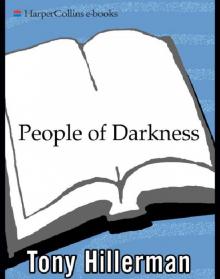 People of Darkness
People of Darkness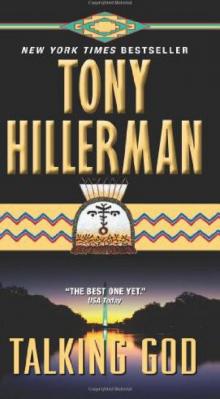 Talking God jlajc-9
Talking God jlajc-9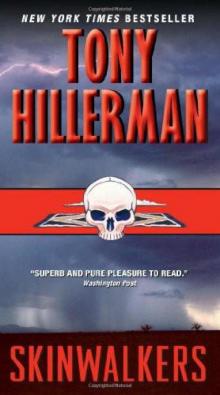 Skinwalkers jlajc-7
Skinwalkers jlajc-7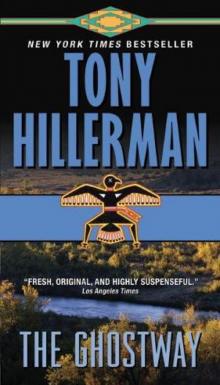 The Ghostway jlajc-6
The Ghostway jlajc-6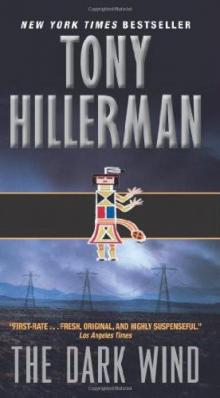 The Dark Wind jlajc-5
The Dark Wind jlajc-5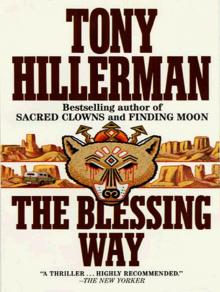 The Blessing Way
The Blessing Way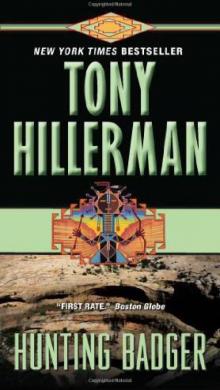 Hunting Badger jlajc-14
Hunting Badger jlajc-14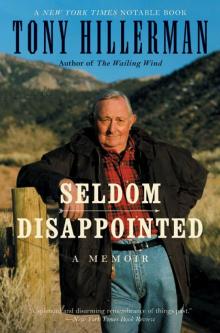 Seldom Disappointed: A Memoir
Seldom Disappointed: A Memoir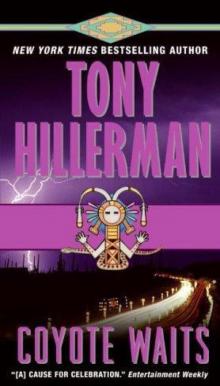 Coyote Waits jlajc-10
Coyote Waits jlajc-10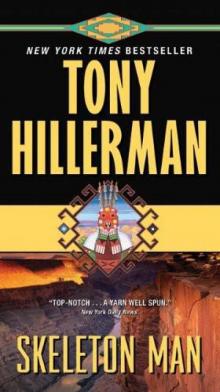 Skeleton Man jlajc-17
Skeleton Man jlajc-17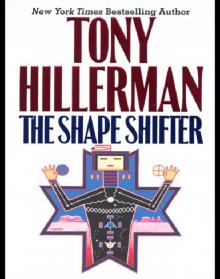 The Shape Shifter
The Shape Shifter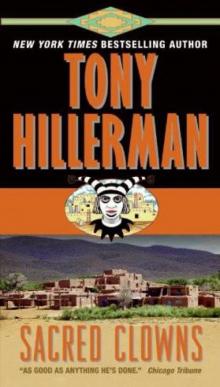 Sacred Clowns jlajc-11
Sacred Clowns jlajc-11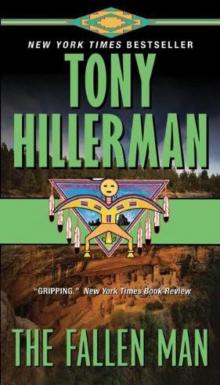 The Fallen Man jlajc-12
The Fallen Man jlajc-12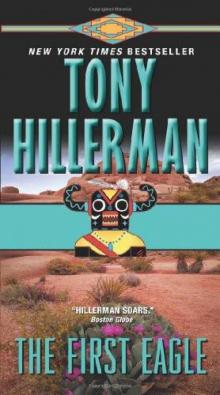 The First Eagle jlajc-13
The First Eagle jlajc-13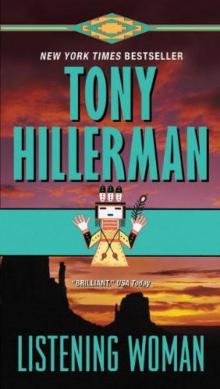 Listening Woman jlajc-3
Listening Woman jlajc-3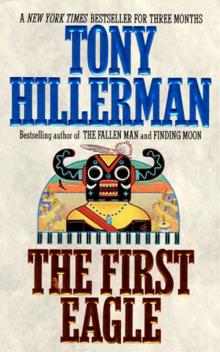 The First Eagle
The First Eagle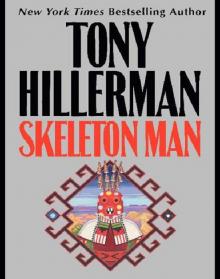 Skeleton Man
Skeleton Man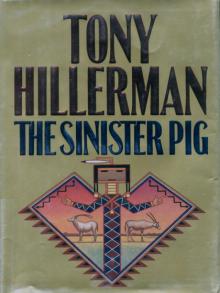 The Sinister Pig jlajc-16
The Sinister Pig jlajc-16 People of Darkness jlajc-4
People of Darkness jlajc-4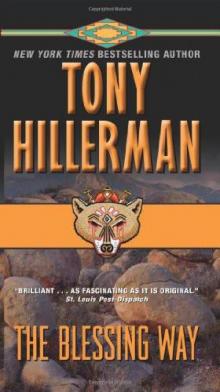 The Blessing Way jlajc-1
The Blessing Way jlajc-1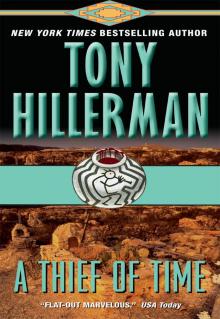 A Thief of Time
A Thief of Time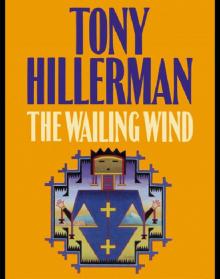 The Wailing Wind
The Wailing Wind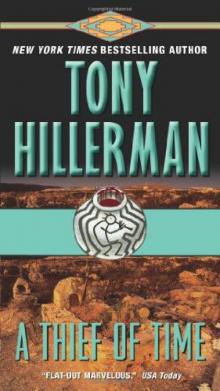 A Thief of Time jlajc-8
A Thief of Time jlajc-8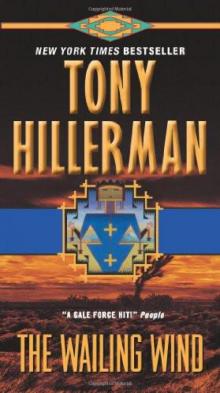 The Wailing Wind jlajc-15
The Wailing Wind jlajc-15 The Shape Shifter jlajc-18
The Shape Shifter jlajc-18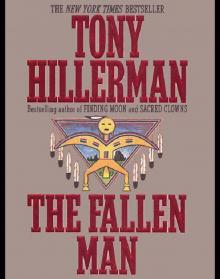 The Fallen Man
The Fallen Man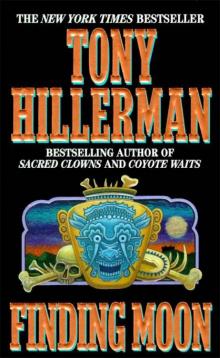 Finding Moon
Finding Moon